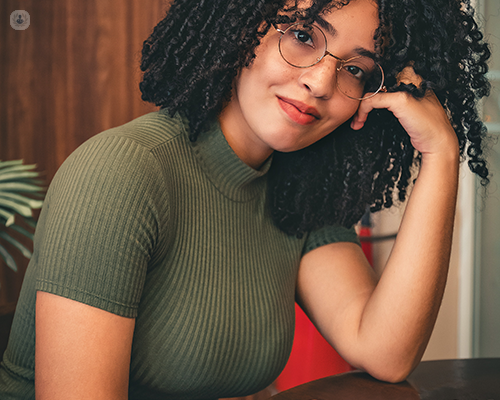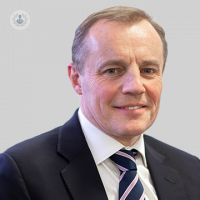Breast reduction surgery: eight important questions to consider
Escrito por:Breast reductions, like any surgical procedure, require thorough consideration with several important aspects that should have specialist input. Mr Paul Roblin, a plastic, aesthetic and reconstructive surgeon with leading expertise in breast surgeries, talks you through eight important questions to consider.

1. Why might a woman opt for breast reduction surgery?
There are several reasons why a woman may wish to have a breast reduction. It may be for cosmetic reasons or that they are self-conscious about the size of their breasts.
Often, women opt for a reduction for more functional reasons:
- They are suffering from back and neck pain caused by the weight of their breasts.
- Their bra straps are digging in.
- The weight of their breasts is contributing to poor posture.
- They have a rash underneath the breasts.
- The weight and discomfort are restricting sporting activities.
2. Is it possible to achieve their desired breast cup size?
It is possible to achieve the desired cup size, but it’s important to understand that cup sizes are very subjective measurements and not very accurate. What a surgeon and a lady undergoing breast reduction surgery think is a certain breast cup size may not be exactly the same.
It is also important to think about the proportion of the breasts to the rest of the body. In some woman (for example those who are tall and wide framed), a surgeon may advise that the breast does not become too small as a good shape may not be possible.
Overall, the surgeon must have as good an understanding as possible of the size that the woman is trying to achieve.
3. Will the breasts also be lifted?
A breast reduction procedure has two components. One is to reduce the volume or weight of the breast and the other is to lift and reshape the breast. To do this, the nipple and areola are lifted to a higher (non-droopy) position.
4. What happens during the procedure?
The procedure usually takes about two hours. Local anaesthetic may be injected into the breast and antibiotics are given at the start of the procedure. The surgeon will make a cut around the border of the areola and a vertical cut down to the crease underneath the breasts. In most patients, this cut will also extend along the length of this crease under the breast. In some patients, it may be possible to limit the length of the cut needed in this crease.
Before the procedure, the new site for the nipple is marked. This is usually at the level of the crease underneath the breast. The cut made around the border of the areola is continued into the breast. This is so that the areola is supported by a block of tissue (pedicle) which maintains its blood supply. This pedicle is then lifted and rotated to allow the nipple and areola to sit in the new position.
For some woman with very large and droopy breasts, the distance that the nipple has to be moved means that the pedicle of tissue that supports the blood supply to the nipple becomes too long, as well as being rotated, for the nipple and areola to survive. If this is the case, the surgeon may recommend that the nipple and areola are removed from the breast, like a skin graft, and reattached once the lift and reduction have been performed.
The excess breast tissue and skin are removed and the breast lifted and reshaped. The skin is closed with buried sutures which will dissolve over a number of months. A suction drain is placed in each breast and this is usually removed the next day before discharge home.
5. Will there still be sensation in the nipples after surgery?
When making the pedicle (the block of tissue) for the nipple and areola to be moved, the nerves supplying it will be divided. Pedicle types can vary in their thickness and how much tissue is cut, but with all the variations there will be a change or reduction in the sensation to the nipple. This will gradually improve over a year to 18 months but may not return to normal.
If the nipple and areola are moved as a skin graft, the sensation will be lost permanently.
6. Will it be possible to breastfeed in the future?
When the pedicle to move the nipple and areola is formed, breast tissue is cut. Whilst doing this, the ducts going to the nipple will also be divided. The number varies with the different types of pedicles, but with all of these there will be a reduced ability to breastfeed.
When the nipple and areola are moved as a skin graft, all of the ducts will be cut and breastfeeding will not be possible.
7. What are the potential complications of breast reduction surgery?
With a general anaesthetic, there is a risk of blood clots forming in the veins in the leg which could travel to the lungs causing breathing difficulties. You will be given an injection and compression stockings to prevent this.
As with any operation, there will be:
- Some pain (which should be controlled with standard pain killers)
- Bruising
- Swelling
- Scars (which may be red and lumpy or stretch)
- Wounds that may gape (and require dressings)
- Loss of skin
- Infection
- Bleeding and seroma (clear fluid collecting inside the wound)
Occasionally, an area of breast tissue can harden because the blood supply to it had been reduced. This usually settles and softens over a number of months but can occasionally become permanent.
Cosmetic problems are possible with the breast being too large, too small, or asymmetrical.
8. How soon will I recover
Women usually stay in the hospital for one night after the procedure. A compression support bra (preferably one without underwires and that has a zip at the front) is put on in the theatre and worn for 24 hours a day for the first week. This is worn in the daytime for six weeks following the procedure.
Women undergoing this surgery should not lift anything heavy or drive a car for two weeks following the procedure. Depending on their job, they should be able to return to work in 10 to 14 days.
You can receive Mr Roblin’s first-class patient care – learn more and arrange your first consultation.


